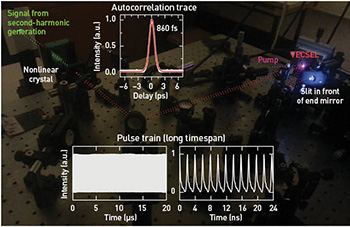 Self-mode-locked quantum-well semiconductor disk laser: Green light is externally produced via second-harmonic generation with the infrared pulsed laser light. Inset: The autocorrelation trace shows the pulse width of 860 fs (top). The diagram of the long-span pulse train is shown at the bottom (left). The close-up of the pulse train reveals a 500 MHz repetition rate for the fundamental mode (right).
Self-mode-locked quantum-well semiconductor disk laser: Green light is externally produced via second-harmonic generation with the infrared pulsed laser light. Inset: The autocorrelation trace shows the pulse width of 860 fs (top). The diagram of the long-span pulse train is shown at the bottom (left). The close-up of the pulse train reveals a 500 MHz repetition rate for the fundamental mode (right).
Vertical-external-cavity surface-emitting lasers (VECSELs), also called semiconductor disk lasers, are versatile lasers that serve as an excellent platform for the realization of various emission schemes due to their remarkable design flexibility and features. In recent years, researchers have achieved not only high-power multimode or single-frequency continuous-wave operation, but also two-color and mode-locked emission. Furthermore, their external resonator can be exploited for intra-cavity frequency conversion via nonlinear elements, which drastically expands the accessible wavelength range. VECSELs have become particularly appealing sources of pulsed laser light, because they can provide an outstanding beam quality and a high pulse peak power.1 Their potential to become compact, cost-efficient alternatives to commercial mode-locked lasers led to the pursuit of devices with ever shorter pulses, higher peak powers and enhanced tunability using resonator-integrated or even chip-integrated semiconductor saturable-absorber mirrors (SESAMs). However, the complex, power-sensitive and costly SESAMs, which have to be carefully designed for a certain wavelength range, naturally impose limitations on the performance of the device.
We have demonstrated SESAM-free VECSELs operated under self-mode-locking (SML) conditions. The SML scheme is not only applicable to quantum-well VECSELs,2–4 but also to quantum-dot devices.5 Furthermore, SML can be used for passively harmonically mode-locked devices with sub-ps pulsed operation demonstrated at discrete power levels up to the third harmonic.4 We do not yet have a full understanding of the mechanism behind SML, which could allow the full utilization of its effects, and so this will be the subject of future studies. Nevertheless, an optimization of the dispersion and thermal management promises the achievement of shorter pulses in the 100 fs range and significantly higher peak powers exceeding the current values of up to 1 kW at repetition rates ranging from a few hundreds of MHz to a few GHz. We believe that in the near future, SML VECSELs, which combine the advantages of solid-state and semiconductor devices, can become robust, compact and low-cost sources of fs pulsed laser light.
Researchers
A. Rahimi-Iman, M. Gaafar, W. Stolz and M. Koch, Philipps-Universität Marburg, Germany
E.U. Rafailov, Aston University, U.K.
References
1. K.G. Wilcox et al. Opt. Express 21, 1599 (2013).
2. Y.F. Chen et al. Opt. Lett. 36, 4581 (2011).
3. L. Kornaszewski et al. Laser Photon. Rev. 15, 20 (2012).
4. M. Gaafar et al. Electron. Lett. 50, 542 (2014).
5. M. Gaafar et al. Opt. Lett. 39, 4623 (2014).
